|
Users' pursuit of faster speed has been running through the entire development of 802.11. The development of wireless and chip technologies makes the implementation easier and cheaper. In 11ax, there are also some new features that increase the physical layer link rate. 1024QAM QAM (Quadrature Amplitude Modulation) conveys 2 orthogonal carrier waves of the same frequency with double data to improve spectrum utilization. QAM has a wide range of applications in communication technologies such as Wi-Fi and cellular networks. In the field of digital communications, the constellation diagram is usually used to visually represent signals and the relationship between signals. QAM is a modulation method that combines amplitude and phase variations, which means that different information is represented by different phase and amplitude combinations of the signals. As shown in the below 16QAM constellation diagram, the data "1100" is represented by a combination of phase 225 and amplitude 25%. 1 signal unit of 16QAM represents 4 bits (16 types) of data. 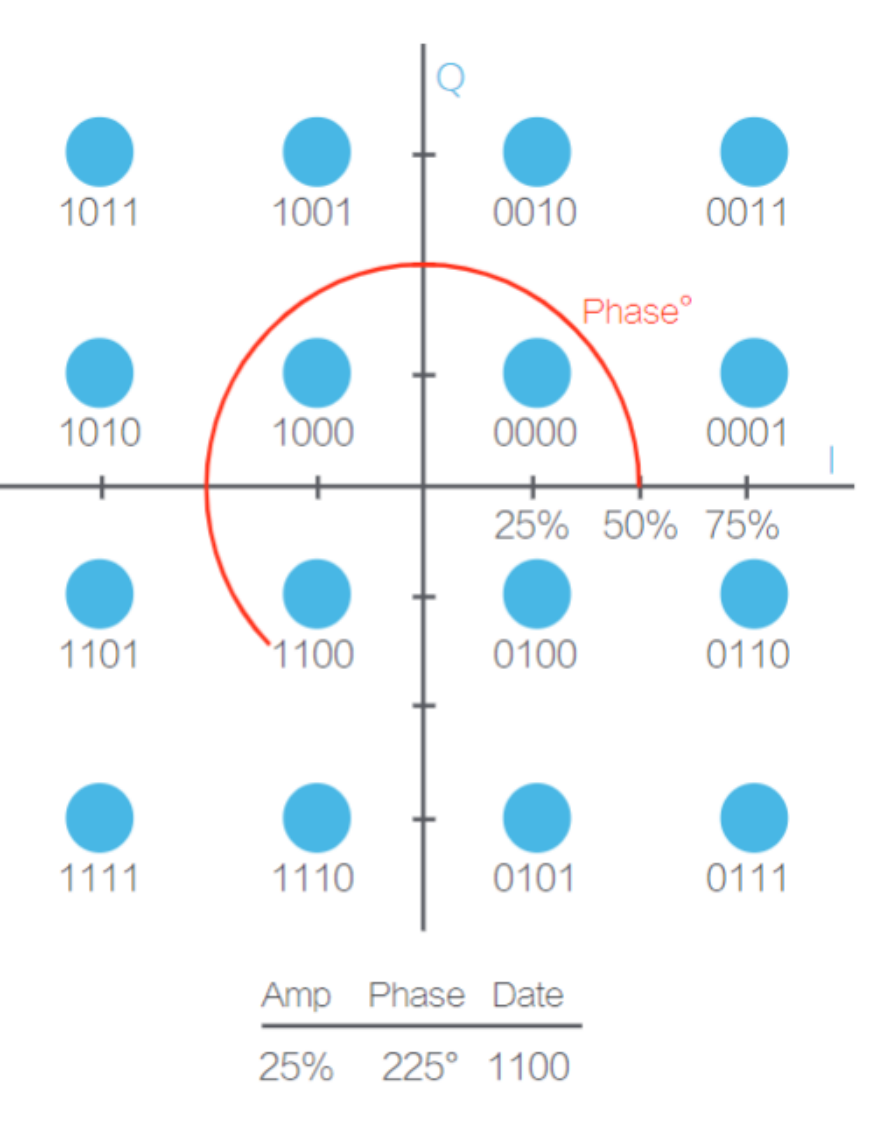 A maximum of 256QAM is supported in the 11ac era. 11ax introduces a higher-order coding, 1024QAM. A signal unit of 1024QAM represents 10 bits (1024 types) of data, which offers 25% higher performance than 256QAM. 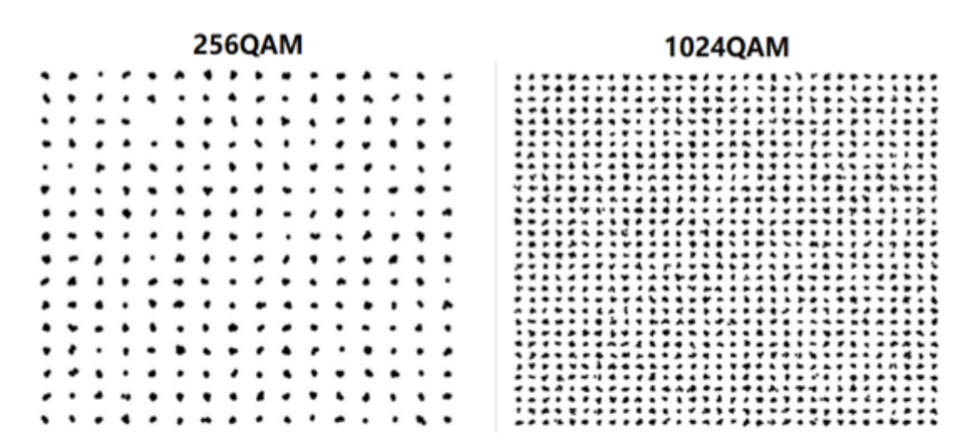 Due to the increase in the information density of 1024QAM, the difference between signals carrying different codes is also smaller, and the requirements for signal quality are also higher. Therefore, the technology can only fully exert its advantages in a scenario with excellent wireless environment and relatively close distance, such as small office and conference room with good signal. Long OFDM Symbol Long OFDM symbols are used in 11ax, which has three functions: 1. Improve the stability of outdoor communication 2. Enhance the tolerance of delay jitter in UL MU-MIMO and OFDMA communications 3. Improve the efficiency of indoor communication (lower GI time ratio), which is the effect of speed increase discussed in this section In the OFDM coding of Wi-Fi, the information is divided into a number of small OFDM symbols (the blue section of the figure below). GI (guard interval, the red section in the figure) is inserted between the symbols to reduce the mutual influence between the symbols. Longer symbol length is used in 11ax, which reduces the proportion of GI and improves performance. Take a typical indoor deployment as an example. In the 11ac network, the GI is 0.4us or 0.8us, and the symbol length is 3.2us. I.e. the payload accounts for 80%. In the 11ax network, the GI is 0.8us and the symbol length is 12.8us. I.e. the payload accounts for 94%. Therefore, in the same QAM debugging mode, the HE (11ax) speed increases by 14%.This performance gain exists in all types of HE speeds from MCS1 to MCS11, so the users can enjoy the performance gain brought by long symbols regardless of the speeds they use and their environments. 8*8 MIMO Although support for 8x8 MIMO spatial streams has been mentioned in the 11ac protocol, there are no mature commercial applications in the 11ac era. With the advancement of technology, mature 8x8 commercial products have emerged in the 11ax era. This not only improves the maximum throughput performance per user, but also supports MU-MIMO for more users, improving the throughput performance of multi-user concurrency. <span style=""">  </span> <span style="text-align: justify;">Higher Efficiency</span> <span style="text-align: justify;">Historical Wi-Fi protocols focus on increases of physical link rates. In addition to the preceding increases of link rates, 802.11ax is more innovative in its support for multi-user high-density scenarios.</span> <span style="text-align: justify;">Wi-Fi communication is based on the enhanced distributed channel access (EDCA) contention model. Therefore, all STAs need to contend on same channels, which wastes much time due to backoff and waiting. Contention overheads significantly increase as the number of STAs grows. To reduce such wastes, orthogonal frequency division multiple access (OFDMA), multi-user multiple-input multiple-output (MU-MIMO), spatial reuse (SR), and other technologies are introduced.</span> <span style="text-align: justify;">DL/UL OFDMA</span> <span style="text-align: justify;">Instead of increasing physical rates, OFDMA boosts multi-user communication efficiency through user concurrency in frequency domain. OFDMA has been successfully applied to LTE, and can theoretically enable better stability in actual scenarios than MU-MIMO, and therefore receives high expectations in 802.11ax.</span> <span style="text-align: justify;">Basic OFDM Knowledge</span> <span style="text-align: justify;">This section first describes orthogonal frequency division multiplexing (OFDM) for better understanding of basic OFDMA theories below. OFDM is applied to 802.11a, 802.11g, 802.11n, and 802.11ac.</span> <span style="text-align: justify;">Different from single-carrier modulation schemes, OFDM divides the entire carrier band into a large number of adjacent sub-bands (subcarriers). Each subcarrier adopts a conventional modulation scheme for modulation at a low symbol rate.</span> <span style="text-align: justify;">  </span> <span style="text-align: justify;">For example, a 20 MHz band of 802.11ac is divided into 64 subcarriers, with each subcarrier having a frequency channel width of 312.5 kHz. Each subcarrier is subdivided into 3.2 μs elements and 0.8 μs guard intervals (GIs). A transmit end generates time-domain signals through inverse Fourier transform by using the 64 subcarriers for signal sending. A receive end decomposes the signals into the 64 subcarriers through Fourier transform, demodulates data on each subcarrier, and obtains the sent data via reassembly.</span> <span style="text-align: justify;">OFDM features high spectrum efficiency, high channel width scalability, and resistance to multipath fading, and therefore is widely applied to the wireless communications.</span> <span style="text-align: justify;">OFDMA</span> <span style="text-align: justify;">OFDMA evolves from OFDM. In OFDM, all subcarriers in one packet are used for communication with a single user. In OFDMA, different subcarriers in one packet can be allocated to different users for concurrent communication.</span> <span style="text-align: justify;">  </span> <span style="text-align: justify;">As shown in the preceding figure, OFDMA reduces preambles, interframe spaces such as short interframe spaces (SIFSs), and contention backoff time of STAs, thereby increasing communication efficiency in concurrency scenarios.</span> <span style="text-align: justify;">Subcarriers and RUs</span> <span style="text-align: justify;">802.11ax specifies the following types of subcarriers:</span> <span style="text-align: justify;">1. Data subcarriers: used to transmit data</span> <span style="text-align: justify;">2. Pilot subcarriers: distributed among data subcarriers, helping the data subcarriers in phase synchronization.</span> <span style="text-align: justify;">3. Unused subcarriers: further classified into direct current (DC) subcarriers, guard band subcarriers, and null subcarriers. These subcarriers provide assistance and protection.</span> <span style="text-align: justify;">A data subcarrier set is referred to as a resource unit (RU), and can be allocated to a single user. 802.11ax specifies the following data subcarrier sets of different sizes.</span> <span style="text-align: justify;">1. 26-tone with 2 pilots</span> <span style="text-align: justify;">2. 52-tone with 4 pilots</span> <span style="text-align: justify;">3. 106-tone with 4 pilots</span> <span style="text-align: justify;">4. 242-tone with 8 pilots</span> <span style="text-align: justify;">5. 484-tone with 16 pilots</span> <span style="text-align: justify;">6. 996-tone with 16 pilots</span> <span style="text-align: justify;">Note:Taking 26-tone with 2 pilots as an example, “tone” means subcarrier; “26-tone” indicates an RU composed of 26 subcarriers, and “2 pilots” means two pilot subcarriers. Therefore, “26-tone with 2 pilots” means that the RU consists of 24 data subcarriers and 2 pilot subcarriers. In 802.11ax, each subcarrier has a channel width of 78.125 kHz, and “26-tone” is about 2 MHz, which is the minimum unit of channel width allocatable to a single user.</span> <span style="text-align: justify;">  </span> <span style="text-align: justify;">The preceding figure lists the following four basic RUs:</span> <span style="text-align: justify;">1. 9 x 26-tone: Subcarriers in a single packet are evenly allocated to 9 STAs. (The RU in the middle is split by DC.)</span> <span style="text-align: justify;">2. 4 x 52-tone + 1 x 26-tone: Subcarriers in a single packet are allocated to 5 STAs.</span> <span style="text-align: justify;">3. 2 x 102-tone + 1 x 26-tone: Subcarriers in a single packet are allocated to 3 STAs.</span> <span style="text-align: justify;">4. 1x 242-tone: Subcarriers in a single packet are allocated to 1 STA.</span> <span style="text-align: justify;">The following table lists maximum numbers of RUs of different sizes under various channel widths.</span> <span style="text-align: justify;">  </span> <span style="text-align: justify;">As listed above, under the 80 MHz channel width, 37 or 16 concurrent STAs can be supported, bringing significant gains to typical high-density concurrency scenarios.</span> <span style="text-align: justify;">HE PPDU</span> <span style="text-align: justify;">OFDMA needs a special frame structure to allocate RUs in a single packet to different STAs. An STA needs to know a specific band of the subcarriers to be allocated to the STA.</span> <span style="text-align: justify;">To address the two issues, first learn of the following HE PPDU formats added to 802.11ax:</span> <span style="text-align: justify;">1. HE SU PPDU: used to send packets to a single STA.</span> <span style="text-align: justify;">2. HE Extended Range PPDU: designed for sending packets to a single long-range STA. Packets can be sent only in the primary 20 MHz band by using only one spatial flow and any of MSC 0 to MCS 2. In addition, this format enhances the preamble part in a targeted way.</span> <span style="text-align: justify;">3. HE MU PPDU: used to send OFDMA and HE MU-MIMO packets to one or more STAs.</span> <span style="text-align: justify;">4. HE Trigger-based PPDU: used to send uplink OFDMA or MU-MIMO packets. Such sending is triggered by the trigger packet sent by the AP.</span> <span style="text-align: justify;"> 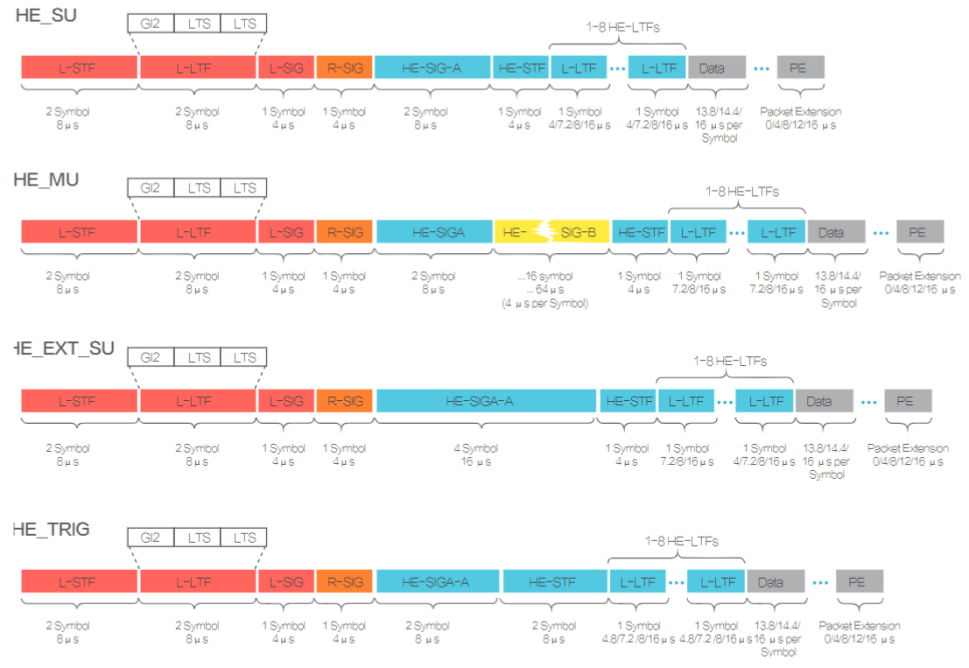 </span> <span style="text-align: justify;"> 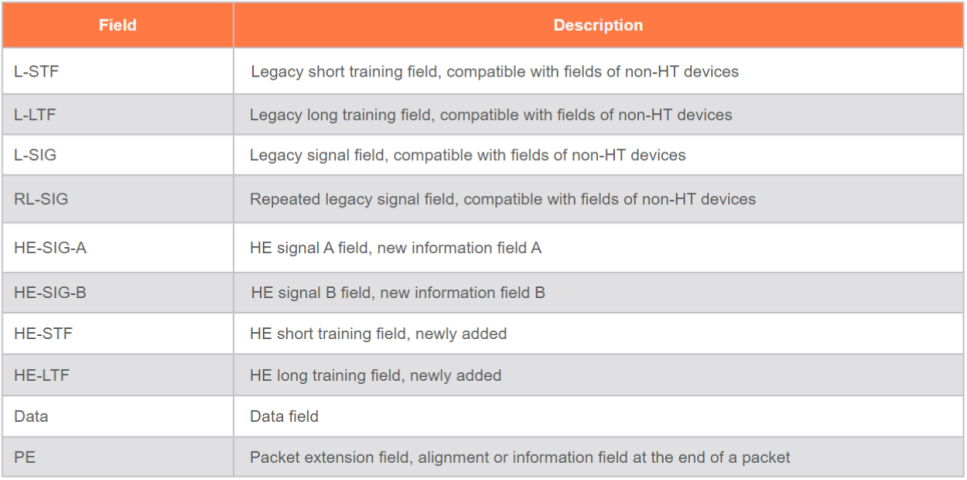 </span> <span style="text-align: justify;">The HE-SIG-B field can address the two issues above.</span> <span style="text-align: justify;">  </span> </span><span style="text-align: justify;">The HE-SIG-B field has a variable length, and consists of the Common field and User Specific field.</span> <span style="text-align: justify;">1. The RU Allocation subfield in the Common field determines the RU allocation scheme and the number of users.</span> <span style="text-align: justify;">2. The User Specific field describes key information of each STA, such as the STA ID, MCS, and coding information. In addition, a user's place in a sorting sequence determines a position and size of an RU to be occupied by the user.</span> <span style="text-align: justify;">Through the HE-SIG-B field, a STA can know whether a received packet is destined for the STA itself as well as a position and size of a corresponding RU, that is, the STA can properly demodulates content in the RU destined for the STA.</span> <span style="text-align: justify;">Trigger Packet and Uplink OFDMA</span> <span style="text-align: justify;">Multiple STAs send uplink OFDMA packets on different sub-bands by using various RUs, similar to the downlink OFDMA packet sending by the AP.</span> <span style="text-align: justify;">For STAs to send uplink OFDMA packets collaboratively, the AP needs to send control packets, namely, trigger packets. After receiving the trigger packets, the STAs jointly send HE TB (trigger based) PPDUs, that is, uplink OFDMA packets after one SIFS.</span> <span style="text-align: justify;">  </span> <span style="text-align: justify;">As shown in the preceding figure, the AP sends a trigger packet to allocate RUs to three STAs. The STAs jointly send HE TB packets after one SIFS. The AP returns an ACK or a BA after receiving the HE TB packet.</span> <span style="text-align: justify;">The trigger packet is a non-HE packet, namely, sent at a conventional rate and compatible with existing devices. The trigger packet is composed of a Common field and a Per-User field.</span> <span style="text-align: justify;"> 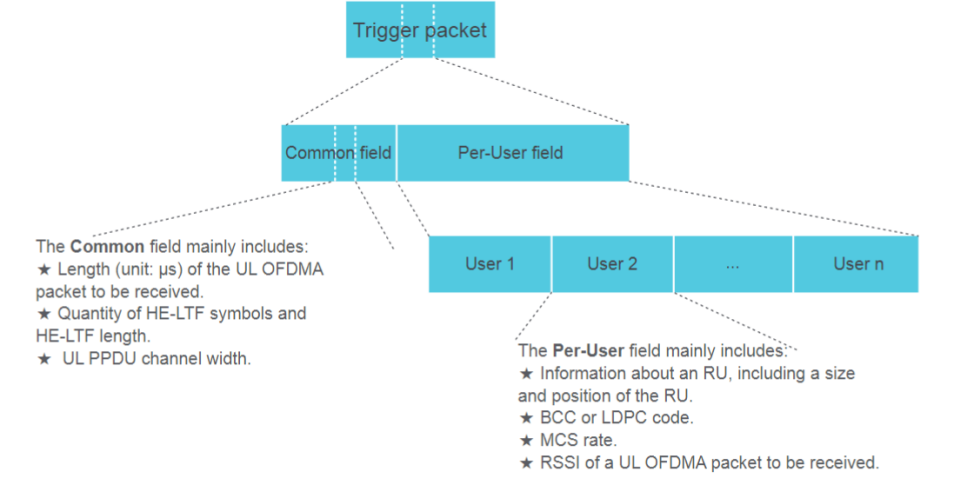 </span> <span style="text-align: justify;">The Common field mainly includes:</span> <span style="text-align: justify;">1. Length (unit: μs) of the UL OFDMA packet to be received</span> <span style="text-align: justify;">2. Quantity of HE-LTF symbols and HE-LTF length</span> <span style="text-align: justify;">3. UL OFDMA packet channel width</span> <span style="text-align: justify;">The Per-User field mainly includes:</span> <span style="text-align: justify;">1. Information about an RU, including a size and position of the RU</span> <span style="text-align: justify;">2. BCC or LDPC code</span> <span style="text-align: justify;">3. MCS rate</span> <span style="text-align: justify;">4. RSSI of a UL OFDMA packet to be received</span> <span style="text-align: justify;"> 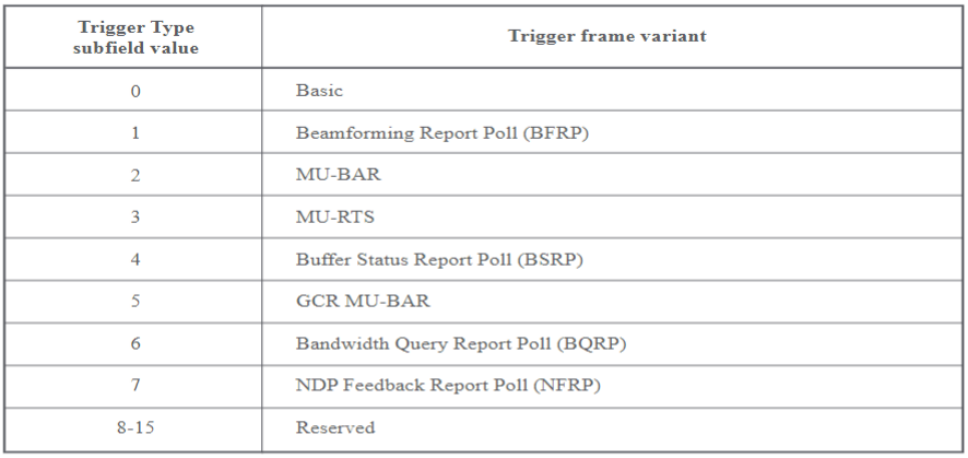 </span> <span style="text-align: justify;">The trigger packet specifies in detail the UL OFDMA packet of each STA, which greatly improves the AP's STA control capability.</span> <span style="text-align: justify;">In addition to scheduling basic UL data packets, the trigger packet can be used for other purposes, for example, beamforming requests, multi-user block ACK requests (MU-BARs), and acquisition of the STA's buffer status.</span> <span style="text-align: justify;">Cascading Mode</span> <span style="text-align: justify;">802.11ax further specifies the cascading mode, which features excessively high communication efficiency. As shown in the following figure:</span> <span style="text-align: justify;">1. The HE MU PPDU sent by the AP includes downlink data, a trigger packet, and an ACK responsive to an uplink packet. The trigger packet triggers the HE TB PPDU of the STA.</span> <span style="text-align: justify;">2. The HE TB PPDU sent by the STA also includes an ACK responsive to a packet delivered by the AP, together with uplink data to be sent.</span> <span style="text-align: justify;">The AP controls and schedules communication on the entire network. Therefore, a communication mode similar to cellular network communication is formed. Compared with the conventional EDCA mode, the cascading mode greatly reduces time wasted by contention backoff and increases network-wide communication efficiency.</span> <span style="text-align: justify;">  </span> <span style="text-align: justify;">DL/UL MU-MIMO</span> <span style="text-align: justify;">802.11ax extends MU-MIMO by supporting UL MU-MIMO and use of MU-MIMO together with OFDMA (optional), and sending packets via HE MU PPDUs.</span> <span style="text-align: justify;">HE DL MU-MIMO</span> <span style="text-align: justify;">802.11ax enables MU-MIMO to be used jointly with OFDMA, and sends packets via HE MU PPDUs.</span> <span style="text-align: justify;">As shown in the following figure, under a 20 MHz channel width, OFDMA subcarriers are divided into three RUs.</span> <span style="text-align: justify;">RU#2 and RU#3 are 52-tone and are respectively sent to two 3x3 STAs.</span> <span style="text-align: justify;">RU#1 is 106-tone, and is subdivided into MU-MIMO spatial flows that will be sent to four 1x1 mobile STAs.</span> <span style="text-align: justify;">Such a delicate design further increases spectrum resource utilization, and provides more options for various complex high-density scenarios.</span> <span style="text-align: justify;">The HE-SIG-B field can also implement this complex combined packet.</span> <span style="text-align: justify;"> 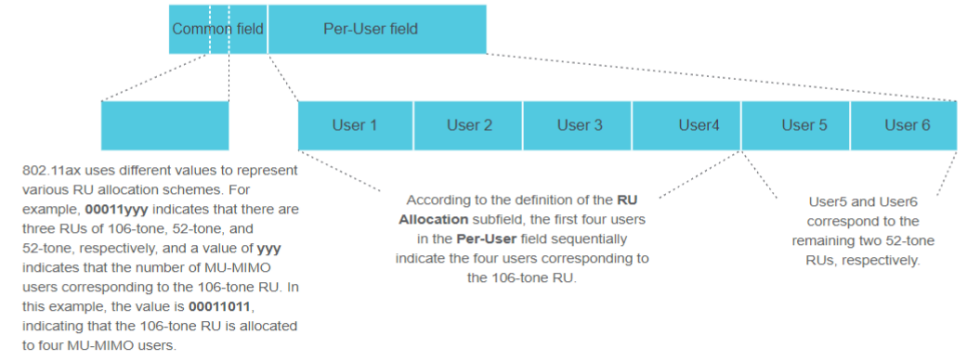 </span> <span style="text-align: justify;">802.11ax gives free rein to form various combinations of OFDMA and MU-MIMO, and can alternatively enable OFDMA transmission and MU-MIMO transmission separately. Combinations of OFDMA and MU-MIMO are not supported until 802.11ax Wave 2 due to its complexity.</span> <span style="text-align: justify;">HE UL MU-MIMO</span> <span style="text-align: justify;">802.11ac supports only downlink MU-MIMO, and uplink ACK packets are sequentially sent, wasting resources. 802.11ax can implement UL MU-MIMO by using a trigger mechanism the same as that of UL OFDMA. For the principle of UL MU-MIMO, see the section "DL/UL OFDMA".</span> <span style="text-align: justify;">Notably, UL MU-MIMO can also be used in the cascading mode, to build an unprecedented communication mode jointly with the combination of OFDMA and MU-MIMO, enabling flexible control and scheduling capabilities for Wi-Fi networks.</span> <span style="text-align: justify;">Spatial Reuse</span> <span style="text-align: justify;">The SR technology reduces co-channel interference between multiple devices, and increases high-density deployment efficiency in the entire network.</span> <span style="text-align: justify;">In a conventional 802.11ac network, multiple co-channel devices cause much contention and backoff. As shown in the figure on the right, AP1 and AP2 share channel 1. AP1 may still cause co-channel interference to AP2 even if network optimization is performed to adjust the coverage. Consequently, AP2 and STA2 need to wait during communication between AP1 and STA1.</span> <span style="text-align: justify;">802.11ax gives free rein to form various combinations of OFDMA and MU-MIMO, and can alternatively enable OFDMA transmission and MU-MIMO transmission separately. Combinations of OFDMA and MU-MIMO are not supported until 802.11ax Wave 2 due to its complexity.</span> <span style="text-align: justify;">HE UL MU-MIMO</span> <span style="text-align: justify;">802.11ac supports only downlink MU-MIMO, and uplink ACK packets are sequentially sent, wasting resources. 802.11ax can implement UL MU-MIMO by using a trigger mechanism the same as that of UL OFDMA. For the principle of UL MU-MIMO, see the section "DL/UL OFDMA".</span> <span style="text-align: justify;">Notably, UL MU-MIMO can also be used in the cascading mode, to build an unprecedented communication mode jointly with the combination of OFDMA and MU-MIMO, enabling flexible control and scheduling capabilities for Wi-Fi networks.</span> <span style="text-align: justify;">Spatial Reuse</span> <span style="text-align: justify;">The SR technology reduces co-channel interference between multiple devices, and increases high-density deployment efficiency in the entire network.</span> <span style="text-align: justify;">In a conventional 802.11ac network, multiple co-channel devices cause much contention and backoff. As shown in the figure on the right, AP1 and AP2 share channel 1. AP1 may still cause co-channel interference to AP2 even if network optimization is performed to adjust the coverage. Consequently, AP2 and STA2 need to wait during communication between AP1 and STA1.</span> <span style="text-align: justify;">  </span> <span style="text-align: justify;">In 802.11ax, the BSS Color field is added to the PHY header of a packet, so that all other STAs identify the “color”of the current packet in an early packet sending stage. If the packet and the STA have the same color, the packet is related to the STA; otherwise, the packet is unrelated to the STA.</span> <span style="text-align: justify;">As shown in the following figure, AP1 and STA1 are marked as blue, and AP2 and STA2 are marked as orange. When AP1 communicates with STA1, a packet with weak signal strength is received by STA2 and AP2. When STA2 and AP2 determine that the color of the packet is different from their own colors and the signal strength of the packet is lower than the threshold, STA2 and AP2 continue with communication and do not need to wait for the AP1's packet transmission to end. In this case, the interference caused by AP1 is weak, and the signal between AP2 and STA2 has an acceptable signal-to-noise ratio. Therefore, AP2 and STA2 can properly demodulate packets.</span> <span style="text-align: justify;"> 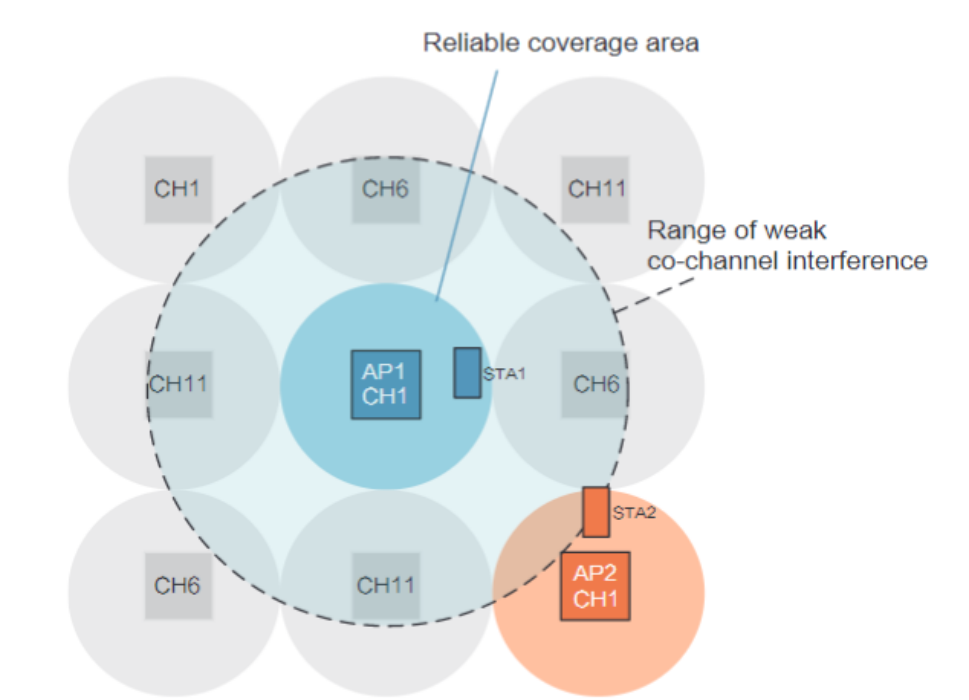 </span> <span style="text-align: justify;">Wi-Fi protocols before 802.11ax all use the clear channel assessment (CCA) threshold to determine whether a channel is busy, thereby determining whether packets can be sent. 802.11 protocols define the following thresholds:</span> <span style="text-align: justify;">1. Carrier sense CCA threshold: The preamble of a packet is detected during carrier sense, to determine the packet start boundary and calculate the signal strength. When the signal strength is greater than this threshold, it is determined that the channel is busy. This threshold is set to –82 dBm.</span> <span style="text-align: justify;">2. Clear channel assessment-energy detection (CCA-ED) threshold: A packet boundary cannot be identified by performing integral energy calculation on a received signal. However, signal strength of a data segment and that of a heterogeneous network (for example, microwave and Bluetooth) can be identified. This threshold is set to –62 dBm.</span> <span style="text-align: justify;">In addition to adding the BSS Color field to the PHY header to indicate the packet “color”, 802.11ax adds signal strength determining thresholds for packets of the same color and those of different colors, to implement the SR:</span> <span style="text-align: justify;">1. Non-spatial reuse group (non-SRG) overlapping basic service set (OBSS) packet detect (PD) level: Indicates the SR signal threshold for non-SRG (different-color) packets. A value ranges from –82 dBm to –62 dBm. A STA calculates the signal strength of the packet preamble. If the signal strength is lower than the threshold, an SR operation can be performed, and other STAs can send packets at limited transmit power.</span> <span style="text-align: justify;">2. SRG OBSS PD level: Indicates the SR signal threshold for SRG packets. A value ranges from –82 dBm to –62 dBm. An AP can send packets to instruct an STA to perform further adjustment within this range. In this way, when the STA sends SRG packets with signal strength lower than this threshold, other STAs can send packets at limited transmit power. network (for example, microwave and Bluetooth) can be identified. This threshold is set to –62 dBm.</span> <span style="text-align: justify;">As shown in the following figure, 802.11ax adds two thresholds. The yellow part indicates the added threshold range in which packets can be sent in the SR state. SR resources and communication efficiency on the entire network are increased.</span> <span style="text-align: justify;"> 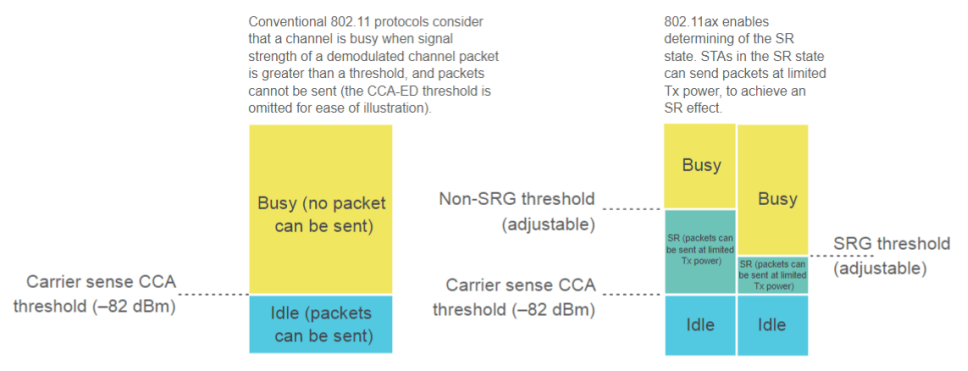 </span> <span style="text-align: justify;">However, the SR mechanism has its own disadvantage. If the SR threshold is improper, excessive interference occurs between packets, affecting signal demodulation. Therefore, in different scenarios and deployment conditions, a proper algorithm is required to support SR parameter adjustment. A device vendor is given more flexibility but is technically challenged. </span> |
|
I love Wi-Fi 6! But why so many HTML syntax in the later part of the post? |
This site contains user submitted content, comments and opinions and is for informational purposes only. Ruijie may provide or recommend responses as a possible solution based on the information provided; every potential issue may involve several factors not detailed in the conversations captured in an electronic forum and Ruijie can therefore provide no guarantee as to the efficacy of any proposed solutions on the community forums. Ruijie disclaims any and all liability for the acts, omissions and conduct of any third parties in connection with or related to your use of the site. All postings and use of the content on this site are subject to the Ruijie Community Terms of Use.
More ways to get help: Visit Support Videos, call us via Service Hotline, Facebook or Live Chat.
©2000-2023 Ruijie Networks Co,Ltd